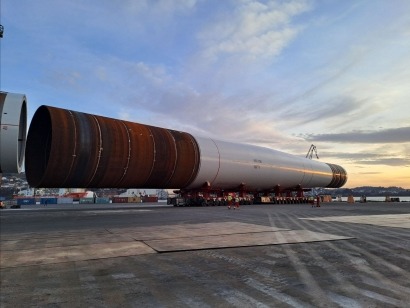
When Navantia Seanergies-Windar Renovables became one of the first companies in Spain to fabricate XXL monopiles, Mammoet assisted with the marshaling of the components at Navantia’s Fene production facility in Ferrol.
Mammoet planned an efficient route to transport the massive monopile foundations to different workstations on the dock, before loading them onto delivery vessels, bound for Scotland, for the Moray West offshore wind farm project developed by Ocean Winds.
With manufacturing schedules and different delivery areas to manage, as well as specialized vessels working to meet deadlines, preparation was essential to support the smooth running of the operation.
The 14 XXL monopiles measured 90 meters in length, 10 meters in diameter and weighed up to 2,000t. All of them were carried out to a storage area once they were manufactured at Fene's workshops.
For installation vessels to lift safely, it is crucial to know the final weight and center of gravity (COG) of each monopile. Once each monopile foundation had completed its final weigh-in, it was then moved to a temporary storage area, near the quayside, where it would wait to be loaded onto delivery vessels in batches of two and three.
SPMT transport: where strength meets flexibility
A total of 60 lines of Self-Propelled Modular Transporters (SPMTs) were used to move the monopile foundations. The trailers were equipped with specialist equipment designed for the movement of XXL monopiles in particular.
The SPMT attachment, a cradle system, comprises foldable saddles that limit the local deflections of the monopile by supporting it as high as possible when in a horizontal position.
This SPMT transport configuration was used to move the monopile foundations to each station and drive them onto the vessels using a ro-ro ramp, avoiding the need for cranes. Mammoet also performed the final weighing operation, which was done using hydraulic jacks and load cells.
The painting station was the biggest challenge on the route, with operators needing to change the orientation of the XXL monopiles, which involved a full 180-degree rotation, before they could enter the area.
In some situations, it was also necessary for painted monopile foundations to be driven directly to the storage area and bypass the weighing station, if it was already in use. This was done to prevent delays to the manufacturing process.
With the logistics happening in tandem with the fabrication, painting and weighing stages, flexibility and good communication was paramount to ensure a fast and efficient process that avoided disruption at the facility and downtime during the operation.

